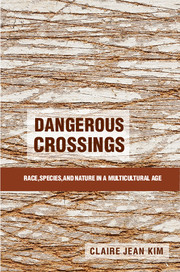Book contents
1 - Impassioned Disputes
Published online by Cambridge University Press: 05 April 2015
Summary
In July 1996, the San Francisco Commission on Animal Control and Welfare held a much-anticipated meeting. For nearly a year, the Commission, an advisory board to the city’s legislative body, the Board of Supervisors, had held heated public hearings on whether to ban the sale of live animals for food in the city, a move that would especially affect the merchants in Chinatown who sell turtles, frogs, birds, fish, and other animals. It was finally time for the Commission to hold a vote. The meeting room at the Taraval Police Station was full and an overflow crowd of hundreds gathered outside. On the street, animal activists held up signs condemning “cruelty” toward animals in Chinatown’s live animal markets, while Chinese Americans held up signs condemning the “cultural imperialism” of their critics. The crowd waited, murmuring. The air was thick with tension. The Commissioners passed the ban with a vote of 7 to 3, with one abstention. When the vote was announced, the crowd roared and police officers escorted Commissioners out of the back of the building for their personal safety.
This turned out to be yet another skirmish in the battle that raged for more than a decade and a half starting in the mid-1990s over the sale of live animals for food in the City on the Bay. After the Commission on Animal Control and Welfare voted, the Board of Supervisors declined to implement the proposed ban, which was, in the trenchant words of one local activist, “a political hot potato.” So, over the next decade and a half, in a long and tortuous journey marked by victories and setbacks alike, animal advocates took their case against the live animal markets to the San Francisco Superior Court, the California legislature, the California Fish and Game Commission, and the public. This protracted struggle generated an occasionally vitriolic and always illuminating discourse in the public sphere about race, species, nature, and culture. It raised vital questions about what constitutes culture; which cultural traditions deserve protection and which do not; who belongs; whether animals are morally considerable; which animals are morally considerable and how much consideration they are due; what constitutes cruelty to animals, environmental damage, and racial harm; how to think about nature; and who has the standing and authority to decide these matters.
- Type
- Chapter
- Information
- Dangerous CrossingsRace, Species, and Nature in a Multicultural Age, pp. 3 - 23Publisher: Cambridge University PressPrint publication year: 2015

